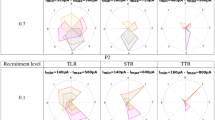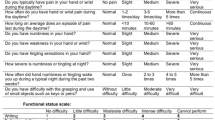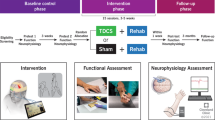Abstract
Study design
A cross-sectional stated-preference survey using direct-assessment questions.
Objective
To determine the relative value placed on different outcomes to be used in a pivotal trial for the upper extremity configuration of the Networked Neuroprosthesis (NNP) as well as the tolerance of the expected adverse event profile.
Setting
Academic medical center in the United States.
Methods
Distribution of an online survey to adults living with tetraplegia; extent of agreement with each question/statement was obtaining using a 1–7 Likert scale.
Results
There were 8 statements about potential benefits in arm/hand function; for all statements, more than 70% of participants rated the functions as “1-very important” to regain. There were variable degrees of concern related to risks that could occur during the 30-day post-surgical period and increasing degrees of concern related to risks that could occur in the first 5 years, potentially due to the device, based on the increasing degree of invasiveness of the intervention required to address the event. When analysing the results based on all degrees of interest, more than 64% of responders were interested in getting the NNP with a success rate threshold as low as 50% regardless of time post-injury. Chi-squared analyses revealed some associations between responses and sex, injury level, and injury duration; however, none of these were statistically significant upon post-hoc analysis.
Conclusion
Data here indicate that people with tetraplegia are highly interested in a range of arm/hand functions and are tolerant of expected risks that may be associated with implanted neuroprosthetics.
Sponsorship
The Institute for Functional Restoration funded this project through a sub-contract to K.D. Anderson from a larger Special Projects Award (grant number FP0020773) from the Craig H. Neilsen Foundation.
Similar content being viewed by others
Log in or create a free account to read this content
Gain free access to this article, as well as selected content from this journal and more on nature.com
or
Data archiving
All survey questions and answer options as well as the raw data used for all contingency tables are included in the Supplementary Material. A copy of the full dataset can be obtained by contacting the corresponding author.
References
Kilgore KL, Peckham PH, Keith MW, Thrope GB, Wuolle KS, Bryden AM, et al. An implanted upper-extremity neuroprosthesis. Follow-up of five patients. J Bone Jt Surg Am. 1997;79:533–41.
Peckham PH, Keith MW, Kilgore KL, Grill JH, Wuolle KS, Thrope GB, et al. Efficacy of an implanted neuroprosthesis for restoring hand grasp in tetraplegia: a multicenter study. Arch Phys Med Rehabil. 2001;82:1380–8.
Wuolle KS, Van Doren CL, Bryden AM, Peckham PH, Keith M, Kilgore KL, et al. Satisfaction with and usage of a hand neuroprosthesis. Arch Phys Med Rehabil. 1999;80:206–13.
Kilgore KL, Hoyen HA, Bryden AM, Hart RL, Keith MW, Peckham PH. An implanted upper-extremity neuroprosthesis using myoelectric control. J Hand Surg Am. 2008;33:539–50.
Peckham PH, Kilgore KL. Challenges and opportunities in restoring function after paralysis. IEEE Trans Biomed Eng. 2013;60:602–9.
Lancaster KJ. A new approach to consumer theory. J Political Econ. 1966;74:132–47.
Kroes EP, Sheldon RJ. Stated preference methods. An Introduction. J Transp Econ Policy. 1988;22:11–25.
Ho M, Saha A, McCleary KK, Levitan B, Christopher S, Zandlo K, et al. A framework for incorporating patient preferences regarding benefits and risks into regulatory assessment of medical technologies. Value Health. 2016;19:746–50.
DeVivo MJ, Biering-Sørensen F, New P, Chen Y. Standardization of data analysis and reporting of results from the International Spinal Cord Injury Core Data Set. Spinal Cord. 2011;45:596–9.
DeVivo M, Biering-Sørensen F, Charlifue S, Noonan V, Post M, Stripling T, et al. International spinal cord injury core data set. Spinal Cord. 2006;44:535–40.
McHugh ML. The chi-square test of independence. Chi Sq Test Indep. 2013;23:143–9.
Anderson KD. Targeting recovery: Priorities of the spinal cord injured population. J Neurotrauma. 2004;21:1371–83.
Donnelly C, Eng JJ, Hall J, Alford L, Giachino R, Norton K, et al. Client-centred assessment and the identification of meaningful treatment goals for individuals with a spinal cord injury. Spinal Cord. 2004;42:302–7.
Snoek GJ, IJzerman MJ, Hermens HJ, Maxwell D, Biering-Sorensen F. Survey of the needs of patients with spinal cord injury: Impact and priority for improvement in hand function in tetraplegics. Spinal Cord. 2004;42:526–32.
Simpson LA, Eng JJ, Hsieh JTC, Wolfe DL. SCIRE Research Team. The health and life priorities of individuals with spinal cord injury: A systematic review. J Neurotrauma. 2012;29:1548–55.
Illes J, Reimer JC, Kwon BK. Stem cell clinical trials for spinal cord injury: Readiness, reluctance, redefinition. Stem Cell Rev. 2011;7:997–1005.
Glanz BI, Greeke E, LaRussa A, Stuart F, Rintell DJ, Chitnis T, et al. Risk attitudes and risk perceptions in individuals with multiple sclerosis. Mult Scler J Exp Transl Clin. 2016;2:2055217316665406.
Fox RJ, Salter A, Alster JM, Dawson NV, Kattan MW, Miller D, et al. Risk tolerance to MS therapies: survey results from the NARCOMS registry. Mult Scler Relat Disord. 2015;4:241–9.
Schwartz CE, Stucky B, Rivers CS, Noonan VK, Finkelstein JA. RHSCIR Network. Quality of life and adaptation in people with spinal cord injury: Response shift effects from 1 to 5 years post-injury. Arch Phys Med Rehabil. 2018;S0003-9993:30117–5.
Dibb B, Ellis-Hill C, Donovan-Hall M, Burridge J, Rushton D. Exploring positive adjustment in people with spinal cord injury. J Health Psychol. 2014;19:1043–54.
Rhodes SD, Bowie DA, Hergenrather KC. Collecting behavioural data using the world wide web: considerations for researchers. J Epidemiol Community Health. 2003;57:68–75.
Mitchell S, Ciemnecki A, CyBulski K, Markesich J, (eds). Removing barriers to survey participation for persons with disabilities. Ithaca, NY: Cornell University Rehabilitation Research and Training Center on Disability Demographics and Statistics; 2006.
Edwards L, Krassioukov A, Fehlings M. Importance of access to research information among individuals with spinal cord injury: results of an evidence-based questionnaire. Spinal Cord. 2002;40:529–35.
Acknowledgements
The authors would like to thank all the individuals living with SCI who took the time to provide input to this study. A special thanks is extended to Dr. Rachel Cowan for statistical advice. An abstract of preliminary analysis of this work has been published in the program book of the 2018 Tetrahand World Congress.
Funding
The Institute for Functional Restoration funded this project through a sub-contract to KDA from a larger Special Projects Award (grant number FP0020773) from the Craig H. Neilsen Foundation.
Author information
Authors and Affiliations
Corresponding author
Ethics declarations
Conflict of interest
The authors declare that they have no conflict of interest.
Additional information
Publisher’s note: Springer Nature remains neutral with regard to jurisdictional claims in published maps and institutional affiliations.
Supplementary information
Rights and permissions
About this article
Cite this article
Anderson, K.D., Bryden, A.M. & Moynahan, M. Risk-benefit value of upper extremity function by an implanted electrical stimulation device targeting chronic cervical spinal cord injury. Spinal Cord Ser Cases 5, 68 (2019). https://doi.org/10.1038/s41394-019-0213-9
Received:
Revised:
Accepted:
Published:
DOI: https://doi.org/10.1038/s41394-019-0213-9



